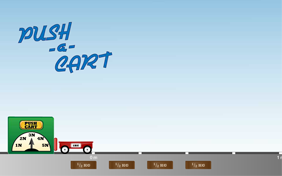Here are some definitions to help you in your investigation.
Motion - tells how something changes its position over time
Force - a push or pull
Newton - a unit for measuring force
Applied Force - a force exerted on an object
Distance - how far something moves
Meters - a unit that measures length or distance moved
Mass - the amount of matter in an object
Weight - the force due to gravity
Kilograms (kg) - a unit for measuring mass
Speed - how fast something is moving
Change in Motion - how quickly an object changes its speed or direction
Net Force - a force that causes a change in motion
Variable - something that changes or can be changed
Reading and Interpreting a Line Graph
What is a Line Graph?
A line graph is a tool that provides a picture using a line or lines to show how things change over time or how they're connected. For instance, you want to see how a plant grows over time. So you measure the plant's height every week. You can use a line graph to see how the plant is growing!
Reading and Interpreting the Graph (See Figure 1.)
• Seeing Changes: Look at the line. If it goes up, the plant is growing! If it stays flat, it's not changing its height, and if the line goes down, the plant is losing height.
• Comparing Weeks: You can easily see which weeks the plant grew the most by looking for the steepest parts of the line.
Finding the Height (See Figure 2.)
• To find the plant height at a certain week, find that Week Number on the bottom line (x-axis), go straight up to the line, and then look across to the Plant Height number on the side (y-axis). On this graph, the plant at week 6 had a height of 9 centimeters.
Extrapolating the Data Beyond the Line (See Figure 3.)
• Following the Trend: If the line is going up or down steadily, you can predict that the plant will continue changing its height at about the same rate in the next few weeks.
• Making a Prediction: You can extend the line a little bit past your last data point (see the dashed line) to make a prediction about the plant's height in the future. But remember, it's just a prediction! Things might change.
Using our extended line in this graph, we predict the plant will have a height of 7 centimeters at week 11.
• Limitations: Extrapolating too far out is not always accurate. The plant could stop growing, or grow at a different rate.
)
What is mass?
Mass is defined as the amount of matter contained in an object. The mass of an object does not change depending on its location. Mass is generally measured in units of grams or kilograms. One kilogram is equal to one thousand grams.
What is force?
A force can simply be defined as any push or pull. However, a more in-depth definition can be applied to the phrase "net force." A net force is any push or pull that causes a change in the motion or shape of an object. If a car is standing still, a net force is needed to start the car moving. If the car's moving, a net force is required to slow it down, speed it up or to change its direction.
What is speed?
Speed is the distance an object travels in an elapsed time. An object traveling at a higher speed will travel a greater distance in the same amount of time as an object moving at a lower speed. A common unit used to measure speed is miles per hour (mph); however, scientists usually prefer a metric measure, such as meters per second (m/s). Speed is a scalar quantity since its value can be expressed only by its magnitude or size.
What is velocity?
Velocity is a vector relative of speed and is defined as the displacement of an object divided by the elapsed time of travel. Displacement differs from distance traveled in that displacement is how far an object is from its starting point. A race car that makes one complete lap on a one-mile long track has traveled a distance of one mile, but has a displacement of zero because the car is back to its original starting position. Since velocity is a vector, it must be defined by a size (how fast) and a direction.
What is acceleration?
Acceleration is the rate of change of velocity over time. Simply put, it is the rate at which an object speeds up or slows down. For example, if a car is standing still and the driver speeds up to 60 miles per hour (mph), the acceleration rate is how quickly the car reached 60 mph. Acceleration also works in the reverse, which is often referred to as deceleration. If the car slows to 20 mph, the deceleration rate is how long it takes the car to slow down. Note that this is different than speed, which is how quickly an object moves over a particular distance.
 Give me a push! How many times have you heard that phrase during your life? But is this saying so easy to comprehend scientifically? Moving an object sometimes requires an in-depth understanding of force, mass, acceleration, velocity, speed, distance, displacement, scalars, and vectors. Whew! That’s a lot to grasp...but that’s my push to get you started on this investigation. Start rolling!
Give me a push! How many times have you heard that phrase during your life? But is this saying so easy to comprehend scientifically? Moving an object sometimes requires an in-depth understanding of force, mass, acceleration, velocity, speed, distance, displacement, scalars, and vectors. Whew! That’s a lot to grasp...but that’s my push to get you started on this investigation. Start rolling!)


